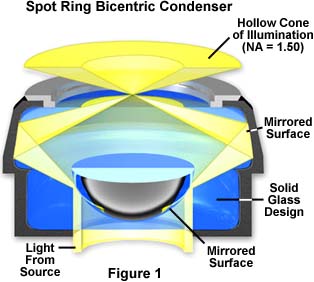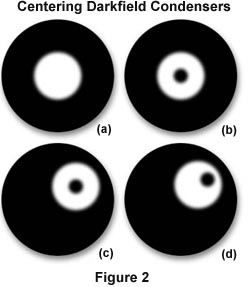Darkfield Microscope Configuration
The following section reviews the steps in the configuration and alignment of a microscope for both low and high magnification transmitted darkfield illumination.
Low Magnification Transmitted Darkfield Microscope Configuration
- A suitable specimen stained for high contrast is selected and placed on the microscope stage for observation and microscope calibration. The 10x objective is selected and the specimen is brought to sharp focus with brightfield illumination.
- Carefully align the optical elements of the microscope and adjust the light source and diaphragms for proper Köhler illumination using the procedures outlined in our section on Köhler illumination setup with a transmitted light microscope.
- Open both the field and substage condenser aperture iris diaphragms to their full-open positions before proceeding any further. This allows the condenser to operate at its maximum numerical aperture. Choose the appropriate central opaque stop (usually about a 16-18 millimeter diameter stop for a 10x objective) and place it onto the spider, glass, or acetate stop holder. Next, insert the stop-holder assembly into the optical path of the microscope by either sliding it into a sub-condenser filter holder or taping it into place on the underside of the condenser.
- If a condenser designed specifically for darkfield illumination at low magnifications is to be used, insert it into the substage condenser mount at this point of the microscope configuration.
- Remove the eyepiece and view the rear focal plane of the objective by peering down the eyepiece tube or by inserting a phase telescope (or Bertrand lens). Often a bright disk of light that is partially obscured by the central opaque stop will be visible at the objective rear focal plane. Ideally, the central stop diameter should be slightly larger than the bright disk and mask it completely. If this is not the case, use the substage centering screws to center the condenser so that the bright disk is completely covered by the central stop.
- Replace the eyepiece and place a low-contrast specimen on the stage that is suitable for observation in darkfield illumination. The image of the specimen should be bright on a very dark background, the only artifacts being small particles of dust and smudges on the microscope slide. If the image is too dark, increase the voltage to the tungsten-halogen light source up to its maximum voltage.
- Focusing the condenser is the last step and should receive careful attention, especially when using objectives above 20x magnification. The top lens of the condenser (when used "dry") should almost come into contact with the underside of the microscope slide. When the condenser is positioned too low in the rack, a dark central region surrounded by a bright ring of light is obvious in the viewfield. This is remedied by raising the condenser until a bright circular area of very small diameter is fully illuminated in the central portion of the viewfield.
- The microscope is now ready for observation and photomicrography of specimens under low magnification darkfield illumination.

High Magnification Transmitted Darkfield Microscope Configuration
- In a manner similar to that with low-power darkfield microscope configuration, place a stained specimen on the stage and using the 10x objective, align the microscope for Köhler illumination as described in our section for transmitted light microscopy.
- Use the condenser rack knob to lower and remove the brightfield substage condenser. Insert the reflected light high numerical aperture condenser into the holder, and secure it with the set screw. Slowly raise the condenser until it is less than 2 millimeters from the underside of the specimen slide.
- Select a darkfield specimen and place it onto the microscope stage between the objective and the condenser. The condenser will project a bright ring of light onto the sample that can be used for centering the optical path. Use the condenser translational centering screws to move the ring of light into the center of the viewfield.
- It is often advantageous to use a low power 10x objective when centering high numerical aperture darkfield condensers. When viewing a specimen with the 10x objective while slowly raising and lowering the condenser, a point will be reached where a bright spot will appear in the field of view as illustrated in Figure 2(a). As the condenser is slightly raised or lowered, a dark spot similar to the one shown in Figure 2(b) will appear, if the condenser is properly centered. In cases where the condenser is not properly aligned and centered, a typical field of view might look like that shown in Figure 2(c), and if the microscope is not properly adjusted for Köhler illumination, the viewfield might appear as it does in Figure 2(d). The ideal and correct positioning of the condenser is illustrated in Figure 2(a), and the condenser should be adjusted until the field of view appears in this manner.
- High numerical aperture darkfield condensers are designed to be used either "dry" or with immersion oil between the top lens of the condenser and the bottom of the microscope slide. To apply oil to an immersion condenser, remove the microscope slide and slowly rack the condenser down below the mechanical stage and place a drop of oil directly on the front lens. Replace the slide, then slowly raise the condenser until contact is made between the oil droplet and the bottom surface of the slide. Carefully observe the oil contact area to determine if any air bubbles have been introduced into the space between the condenser top lens and the microscope slide. It should be noted that no matter what the magnification of the objective is, if an oil immersion condenser is used without oil, light will not emerge from the condenser.
- Air bubbles will scatter light and should be observable by removing the eyepiece and viewing the back focal plane of the objective with either a phase telescope or Bertrand lens. If no bubbles are present, proceed on to the next step. When bubbles are detected, remove all traces of oil from both the slide and the condenser top lens and repeat the procedure. Make certain both surfaces are clean and completely free of oil, dust, dirt and other contaminating artifacts before re-oiling the condenser.
- Select the objective intended for viewing the specimen and swing it into position above the condenser. If the objective is designed to be used dry, then focus the specimen and optimize the illumination by adjusting the condenser focus knob. With oil immersion objectives, place a drop of oil on the front lens of the objective before swinging it into place. Slowly move the objective into place and carefully observe the oil contact area between the objective front lens and the microscope slide. A bright flash should occur (from scattered light) the instant oil on the front lens of the objective lens comes into contact with the microscope slide.
- Check for air bubbles by observing the back focal plane of the objective with a phase telescope or Bertrand lens. If bubbles are present, swing the objective to the next detent stop on the microscope nosepiece and wipe off excess oil with a piece of lint-free lens tissue. Re-apply oil to the objective front lens and try again. When the oil contact area is free of bubbles, use the condenser rack focus knob to optimize darkfield illumination.
- If the objective has an internal iris diaphragm designed to allow adjustment of the numerical aperture, it should be adjusted at this time (this only applies to oil immersion objectives with a numerical aperture higher than 1.20). Remove the eyepiece and place a phase telescope into the eye tube or use a Bertrand lens to observe the rear focal plane of the objective. If a bright ring of light is seen around a central dark region, the aperture of the objective is too great and must be reduced using the internal iris diaphragm, or an objective of lesser numerical aperture should be chosen. Adjust the iris diaphragm until the ring of light falls out of the viewfield. If a crescent-shaped arc of light is observed, then the condenser is not properly aligned in center of the microscope optical axis. Use the condenser centering screws to align the condenser so that the arc disappears or becomes a complete circle of light.
- Replace the eyepiece and focus the specimen, which should now appear brightly and evenly illuminated upon a dark background. When selecting another objective, repeat the steps above to align the condenser and objective for optimized darkfield microscopy.

Careful attention should always be given to microscope alignment, irrespective of whether the illumination mode is brightfield, darkfield, phase contrast or some other contrast enhancement technique. Time spent in this endeavor will be repaid in excellent performance of the microscope both for routine observation and critical digital imaging or photomicrography.
Contributing Authors
Mortimer Abramowitz - Olympus America, Inc., Two Corporate Center Drive., Melville, New York, 11747.
Michael W. Davidson - National High Magnetic Field Laboratory, 1800 East Paul Dirac Dr., The Florida State University, Tallahassee, Florida, 32310.
